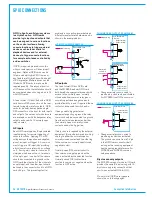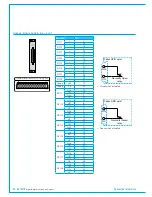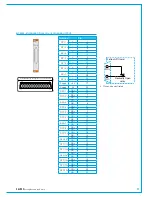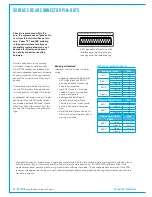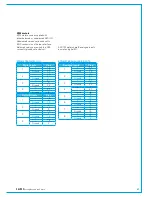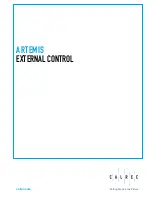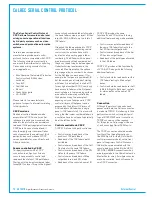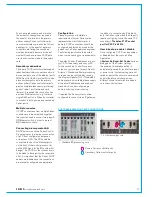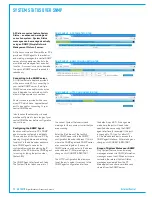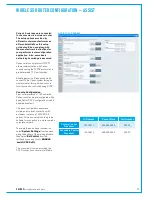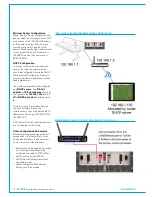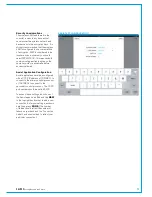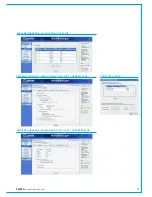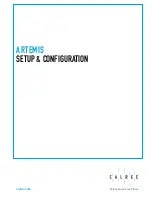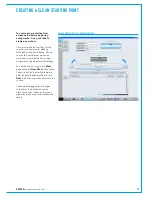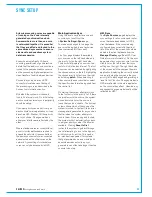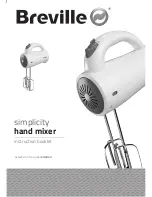
70 ARTEMIS
Digital Broadcast Production Console
External Control
CALREC SERIAL CONTROL PROTOCOL
The Calrec Serial Control Protocol,
CSCP, allows for remote control over
mixing console operational functions
by 3rd party systems such as video
switchers and production automation
systems.
Several broadcast equipment
manufacturers provide serial control
protocols that are compatible with CSCP.
The following systems are currently in
use around the world, actively controlling
Calrec audio mixing consoles for live
on-air applications:
• Ross Overdrive (Automated Production
Control system) & Ross video
switchers.
• Sony ELC.
• Snell Kahuna.
• Mosart.
• Grass Valley Ignite.
• L-S-B VSM.
Please refer to the manufacturer's
guidance for specific information relating
to their products.
CSCPversions
Additional controls have been made
accessible via CSCP since it was first
introduced, requiring new commands be
added to the protocol, and new versions
released. If 3rd party equipment receives
CSCP data it does not understand, it
should simply ignore it, however Calrec
cannot guarantee the operation of third
parties, and as such makes all CSCP
versions available for use on Apollo and
Artemis consoles.
FaderscontrolledbyCSCP
Third party systems with a CSCP
connection to an Apollo or Artemis
console have access to control and
read back the status of 192 path faders.
Starting with the lowest numbered fader
(usually #1) on layer 1A, up to the highest
consecutively numbered fader, followed by
the same fader numbers on layer 1B, then
layer 2A, 2B, 3A, 3B etc. up to a total of
192 faders.
If required, the faders exposed to CSCP
control can be zoned, preventing remote
control over the entire surface width
by intentionally inserting gaps in fader
numbering. The 8 faders within a panel
are always consecutively numbered, but
they do not need to be so between panels.
Under technician level access to the
console's Main Application, the surface
layout page allows a number to be chosen
for the first fader on each panel. If for
example, the first panel is numbered 1-8,
but the second panel, instead of starting
with fader 9, is actually set to start at 10
(or any higher number), CSCP would only
have access to faders on the first panel,
ensuring faders in the remaining surface
area cannot be remotely controlled by
third parties. Using this example of
exposing only one fader panel to CSCP
control, all layers of that panel can be
accessed by the protocol (12 layers x 2
A/B sub-layers x 8 faders on a single
panel = 192 faders total). It is also worth
noting, that the lowest numbered faders in
a control surface do not have to physically
be at the left hand side.
ControlsavailableviaCSCP
CSCP V1.0 allows third party controllers:
• Control over and read back of the
position of 192 path faders.
• Read back of the 192 faders' path /
port labels.
• Control over and read back of the Cut /
On status for the same 192 faders.
• Control over and read back of the PFL
status for the same 192 faders.
• Control over and read back of Main
output bus levels and PFL status.
• Read back of the console's name / ID.
CSCP V2.0 provides the same
functionality as V1.0 with the following
additional features being made available:
• Control over and status read back of
the same 192 faders' routing to the
first 20 Auxiliary output buses.
• Control over and read back of the first
20 Aux bus output levels.
• Read back of the path types allocated
to the 192 faders.
CSCP V2.1 provides all the functionality
of V1.0 & V2.0 along with the following
additional features:
• Control and status read back over the
192 faders' routing to Main output
buses.
• Control and status read back over Left
to Both & Right to Both input controls
for stereo paths on the same 192
faders.
Connection
Although the protocol is based on and
passes serial data, the Calrec connection
is made via TCP/IP. If interfacing to third
party systems which only support point
to point RS232/422 serial connections,
TCP/IP conversion will be required.
For this purpose, Calrec support the use
of, and can supply Perle IOLAN units.
The CSCP connection should be made
to either of the three ethernet ports
(the MAC5 ports for the 8U or older 4U
control processor models) on the front
panel of the primary Control Processor
fitted in the core associated with the
console being controlled (Unlike H2O /
SW-P-08 / EMBER connections which
are always made to the Hydra2 network's
Master Router core). If multiple consoles
are to be controlled, each will require its
own CSCP connection.
Summary of Contents for Artemis
Page 5: ...calrec com Putting Sound in the Picture ARTEMIS INFORMATION...
Page 9: ...calrec com Putting Sound in the Picture ARTEMIS CONTROL SURFACE...
Page 26: ...26 ARTEMIS Digital Broadcast Production Console...
Page 27: ...calrec com Putting Sound in the Picture ARTEMIS PROCESSING CORE BEAM SHINE...
Page 33: ...calrec com Putting Sound in the Picture ARTEMIS PROCESSING CORE LIGHT...
Page 40: ...40 ARTEMIS Digital Broadcast Production Console...
Page 41: ...calrec com Putting Sound in the Picture ARTEMIS CONNECTION INFORMATION...
Page 66: ...66 ARTEMIS Digital Broadcast Production Console...
Page 67: ...calrec com Putting Sound in the Picture ARTEMIS EXTERNAL CONTROL...
Page 80: ...80 ARTEMIS Digital Broadcast Production Console...
Page 81: ...calrec com Putting Sound in the Picture ARTEMIS SETUP CONFIGURATION...
Page 100: ...100 ARTEMIS Digital Broadcast Production Console...
Page 101: ...calrec com Putting Sound in the Picture ARTEMIS PANEL OPTIONS...
Page 110: ...110 ARTEMIS Digital Broadcast Production Console...
Page 111: ...calrec com Putting Sound in the Picture ARTEMIS OBSOLETE PANELS...
Page 114: ...114 ARTEMIS Digital Broadcast Production Console...
Page 115: ...calrec com Putting Sound in the Picture ARTEMIS SPECIFICATIONS...

